Introduction and Package
Introduction
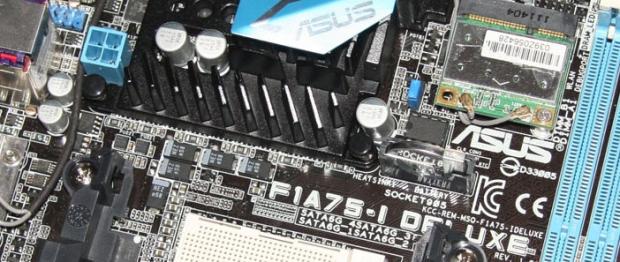
Like every mITX board I see shown on our news page, when I saw the ASUS F1A75-I Deluxe I instantly said to myself "It must be mine". I say it every time, I love the mITX format, but there's just something about an ASUS version of boards. It just tends to stand out more than its competitors.
This was really obvious when ASUS jumped on the Brazos platform; the ASUS E35M-I Deluxe I reviewed in May was an awesome motherboard and the heatsink setup just stood out so much more than other boards we looked at.
Of course, the Lynx platform doesn't have the APU embedded into the board, so we're not going to see the same kind of heatsink setup as it's not necessary. Can the F1A75-I Deluxe stand out from other mITX boards we've looked at recently, though? Well, as always, there's only one way to find out. Of course, before we get into the performance side of things we need to check out the package before we take a closer look at the motherboard.
Once we've done that we'll take a look at the BIOS to see what's going on there before we attempt to overclock the board, something that to date our mITX boards don't like doing. Can ASUS go against the trend, though? We'll find out soon enough, but first let's look at the package of the ASUS board.
The Package
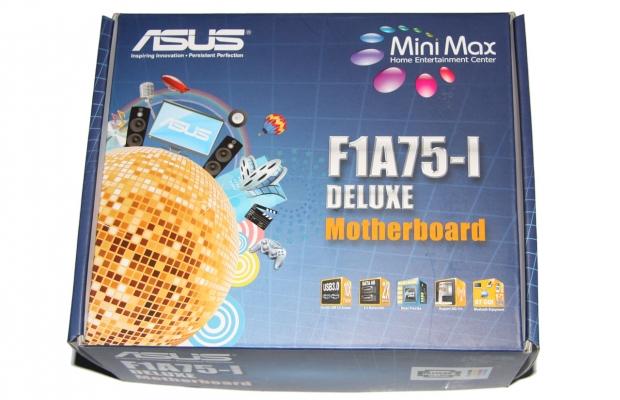
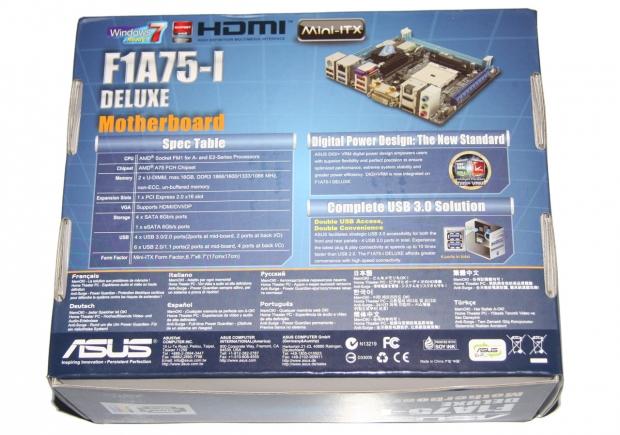
Checking out the box, we don't have any real surprises with that typical ASUS design going on. The front gives us a model and a brief mention of the features on offer, while turning over gives us more of a rundown of what's going on.
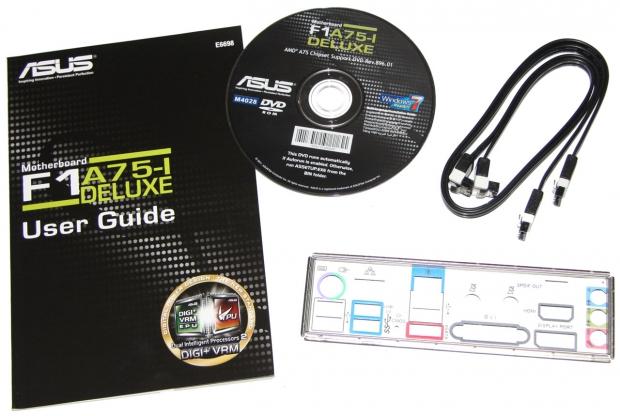
Moving inside the package, we've got the normal culprits included; User Guide, Driver CD, pair of SATA cables and a rear I/O plate.
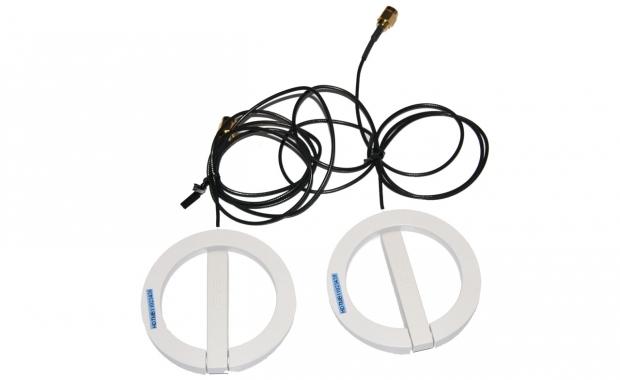
Outside of those normal bits and pieces, we've got a pair of antennas that are used in conjunction with the motherboard.
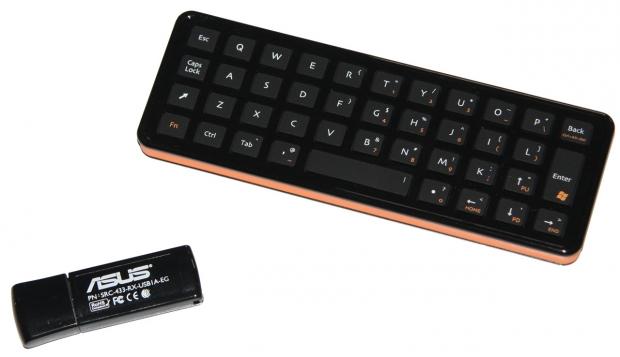
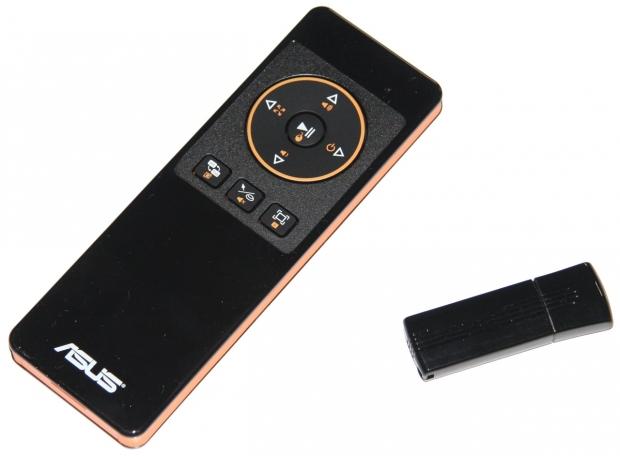
We've also got a remote and USB receiver. The remote is really cool; on one side we've got a full QWERTY keyboard going on that feels great, while on the other side we've got some more typical "media" like buttons. We're starting to see more companies offer these media remotes in the bundle, but ASUS is one of the first to include the QWERTY keyboard on one side which is going to be really handy.
The Motherboard
As usual, when we check out the motherboard in its full form we can pretty much see everything that's going on due to the small stature that the mITX form factor brings with it. We'll move in a little closer, though, and see what exactly is going on.
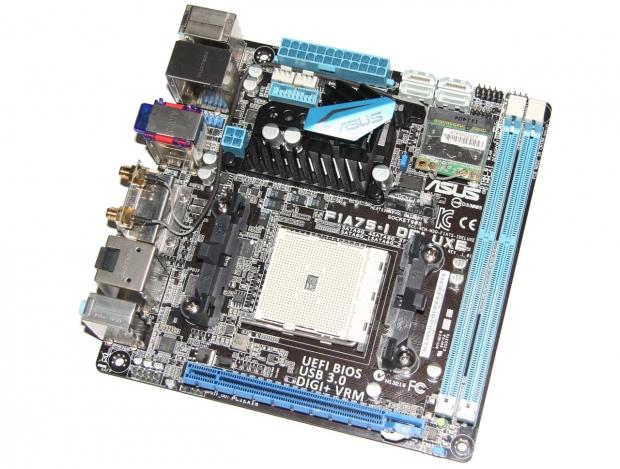

Across the bottom you can see we've got our PCIe x16 slot which runs at x16. Also across the bottom here we've got our front panel and digital audio connectors to pretty much round off the bottom of the board.

Turning the corner, we've got our two DDR3 DIMM slots that support up to 16GB of DDR3 at speeds ranging from 1066MHz DDR too 1866MHz DDR. The only other bit that stands out around here is our MemOK button that can be seen to the right. This is a feature we see on most ASUS motherboards that helps make sure your memory works effectively. To date, though, we haven't had to use it.
The Motherboard Continued
Turning the corner again, we move to the top of the board and here we can see where the bulk of the connectivity is. On the left around our MemOK button we've got a speaker header and our main front panel header. Next to that we've got four SATA ports that all come in at SATA III and run natively off the A75 chipset.

We've also got our main 24-Pin ATX power connector, and above that we've got two CPU fan headers. Above that you can see our USB 3.0 header. The other bit that stands out around here is just above the SATA slots.
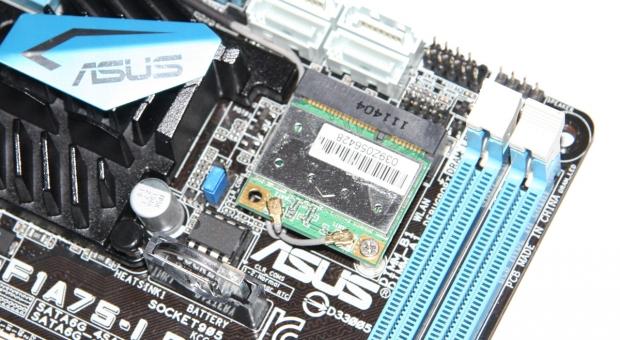
Above our SATA slots you can see our wireless LAN module which has two little cables running off it for the antennas that are provided. Also around here we can see our CMOS battery.
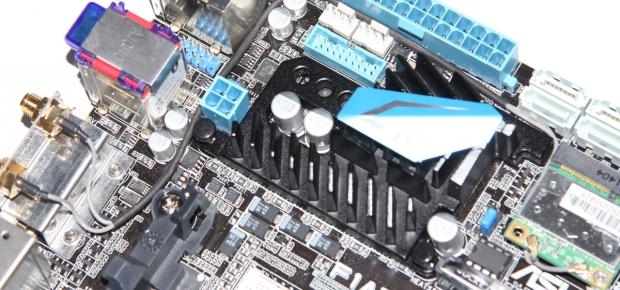
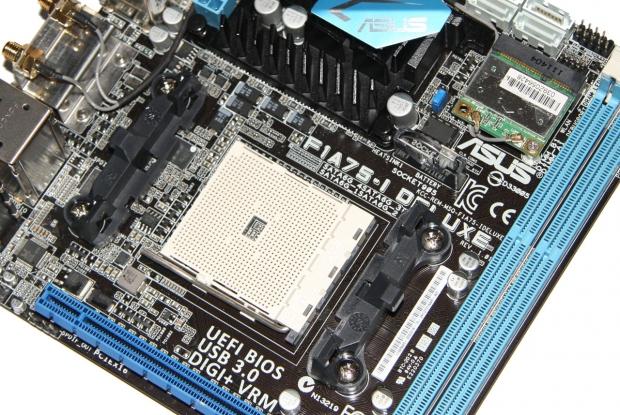
Like most mITX boards, we see that there's a 4-Pin CPU connector included instead of the normal 8-Pin. Around here we can also see that ASUS have gone to the effort to include quite the strong looking heatsink. Below that we've got our GPU area and that really doesn't hold any surprises.

On the I/O side of things we start off with a combo PS/2 port and two USB 2.0 ports; next to that we've got two USB 3.0 ports which run natively off the A75 chipset. Above that we've got a gigabit networking port that runs off the Realtek 8111E controller. Moving across again, we can see a Clear CMOS button, and next to that we have an eSATA port running off the A75 chip. Above that we've got two more USB 2.0 headers and at the top we've got a Bluetooth header.
Next up, we've got our two ports that connect the included wireless antennas and below that we've got a DVI-D port. Next to that we've got a DisplayPort at the bottom and HDMI above that to round off the video connectivity. Finally, we've got an optical port and three auxiliary connections that run off the Realtek ALC892 codec.
BIOS
Firing up the BIOS, you can see we've got that UEFI interface that we've grown to love from ASUS. When you first get in, you're greeted with "EZ Mode" which gives us access to some of the key areas and a run down on some of the main stats.
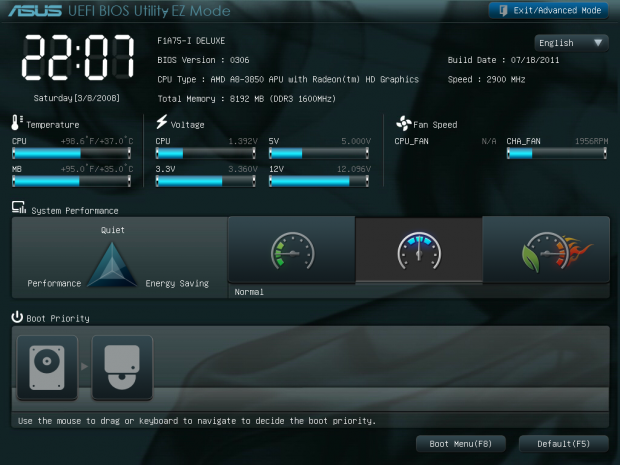
Moving into Advanced mode, you can see again that typical setup that we're used to seeing from the ASUS UEFI BIOS.
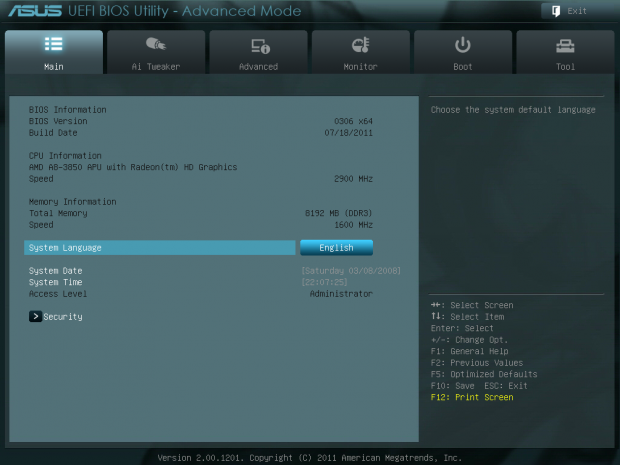
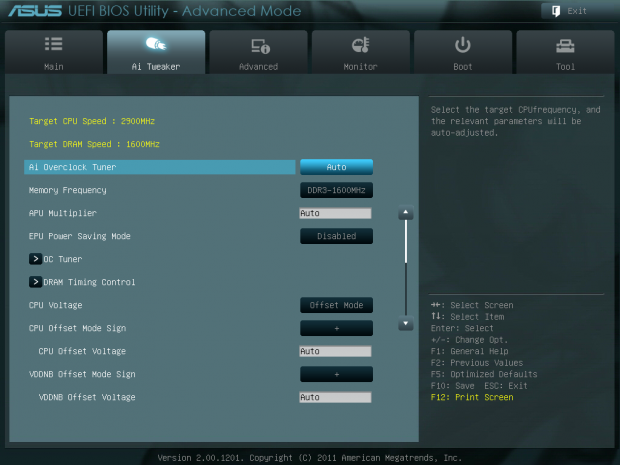
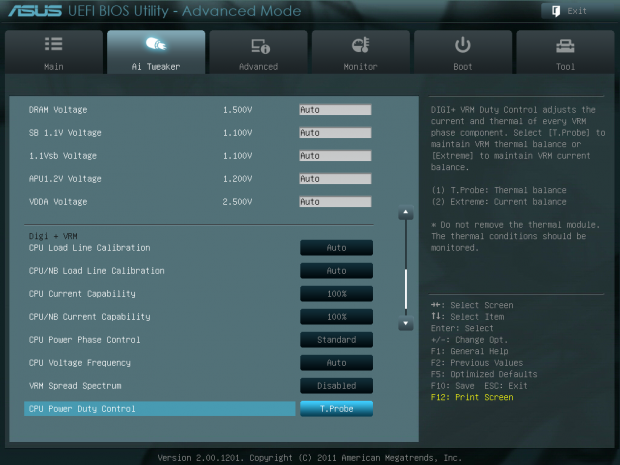
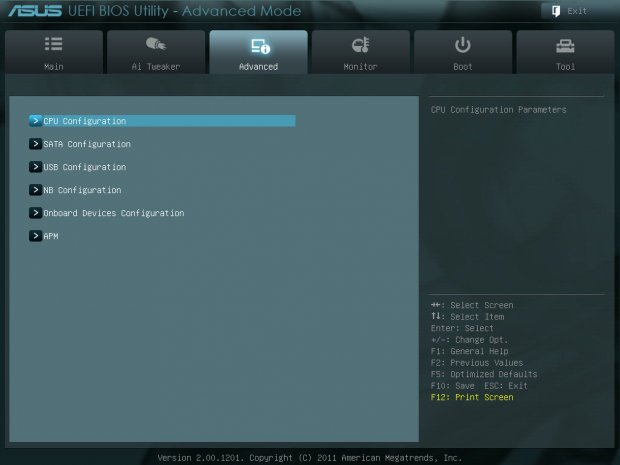
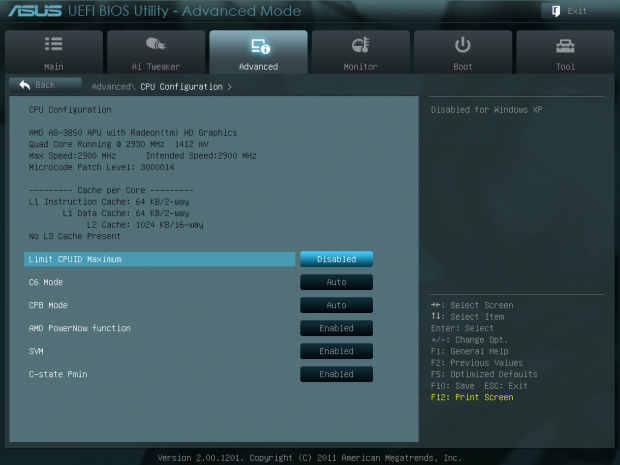
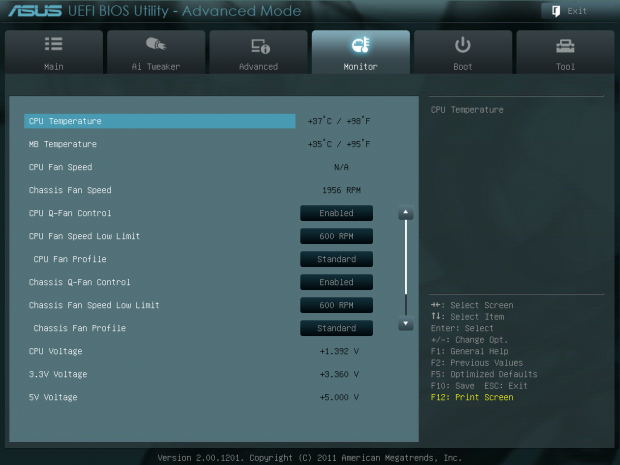
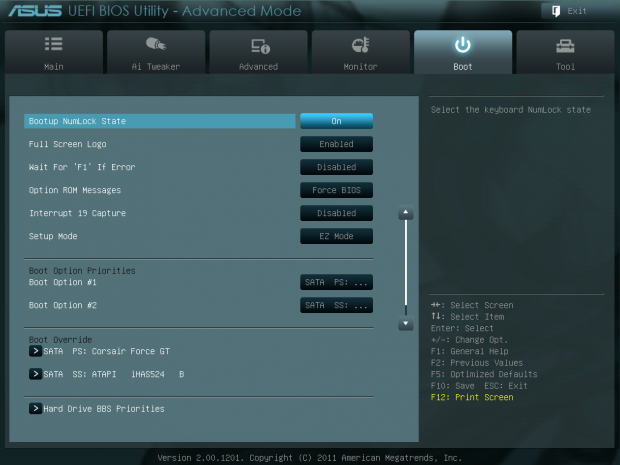
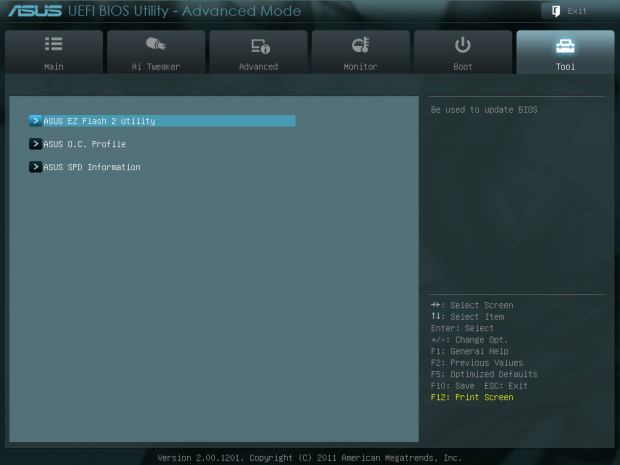
If you're going to do any overclocking, you'll want to jump to the AI Tweaker section. The question is, can we overclock? To date we see most of our mITX boards struggle to offer an overclock. With the meatier looking heatsink included on the board, though, and a strong lineup of options in the BIOS, we've got our fingers crossed that we'll be able to get some extra MHz out of our A8-3850 here today.
Test System Setup and Overclocking
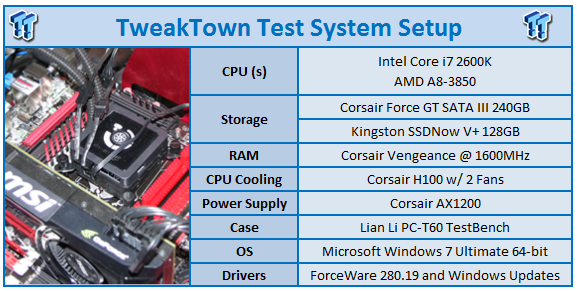
We would like to thank the following companies for supplying and supporting us with our test system hardware and equipment: Intel, ASUS, MSI, Western Digital and Corsair.
On the testbed side of things we haven't got any surprises, so we'll get into the overclocking side of things which yielded some really strong results. The first thing we did was fire up AI Tuner to see what kind of an overclock we could achieve. The software has shown some awesome results when tested on the Z68 / P67 platform, but it gets so much more flexibility because of the ability to adjust the multiplier.
AI Tuner took us to a 109 BCLK which pushed our CPU from 2.9GHz to 3.16GHz. This isn't a huge overclock, but it's stronger than we saw our ASRock A75 mITX board go to. Considering that we got this bump, though, without the need to actually adjust anything in the BIOS, I was hopeful that when I ventured in to the BIOS that we would be able to boost our clock speeds by a good bit more.
With a bit of tweaking here and there, we managed to end up with a really good overclock that was 100% stable when up and running in Windows.
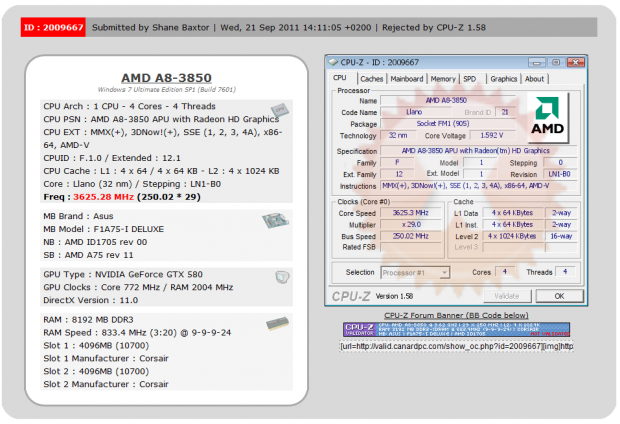
As you can see above, we ended up in Windows at 3625MHz which is a really nice overclock from the default 2.9GHz. CPU-Z continues to be a bit weird when it comes to the validation side of things, but the speed was achieved with a 125 BCLK and a 29x multiplier.
This isn't only a good overclock for the A75 platform, but considering it's done on the tiny mITX format is amazing. Let's see how performance goes when we get up and running.
Let's get started!
CPU Benchmarks
HyperPi 0.99
Version and / or Patch Used: 0.99
Developer Homepage: www.virgilioborges.com.br
Product Homepage: www.virgilioborges.com.br
HyperPi is a front end for SuperPi that allows for multiple concurrent instances of SuperPi to be run on each core recognized by the system. It is very dependent on CPU to memory to HDD speed. The faster these components, the faster it is able to figure out the number Pi to the selected length.
For our testing we use the 32M run. This means that each of the four physical and four logical cores for the i7 and the four physical cores of the i5 is trying to calculate the number Pi out to 32 million decimal places. Each "run" is a comparative to ensure accuracy and any stability or performance issues in the loop mentioned above will cause errors in calculation.
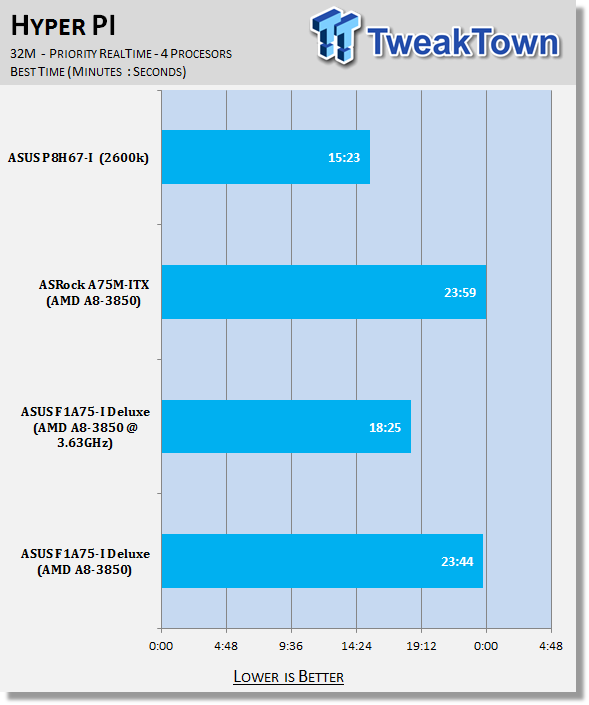
AIDA64
Version and / or Patch Used: 1.00.1035BETA
Developer Homepage: http://www.aida64.com
Product Homepage: http://www.AIDA64.com
Replacing Everest in our labs is AIDA64. This new testing suite is from the core development team from Lavalys and continues that tradition. The guys have thrown in better support for multithreaded CPUs as well as full 64 bit support. We use this to test memory and HDDs for now, but may find ourselves opening this up to other areas of the motherboard.
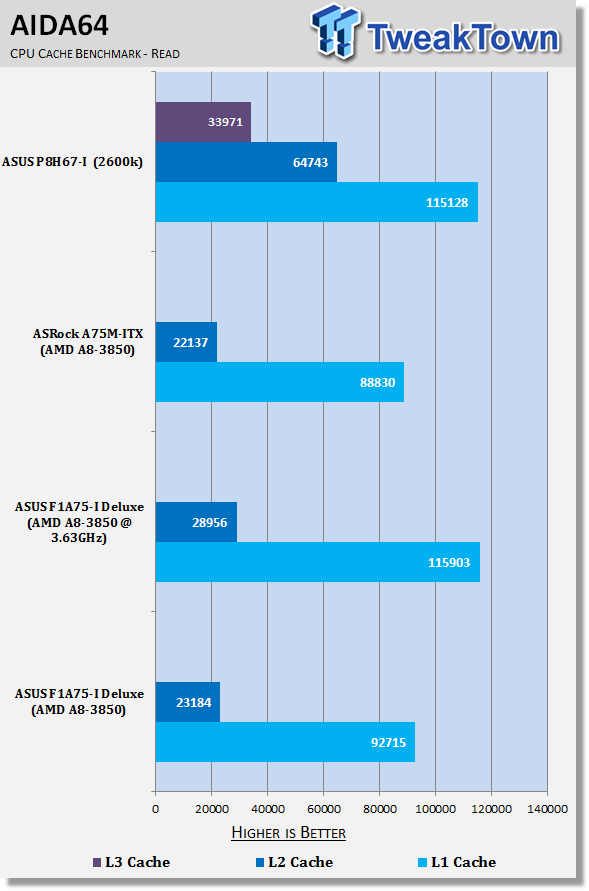
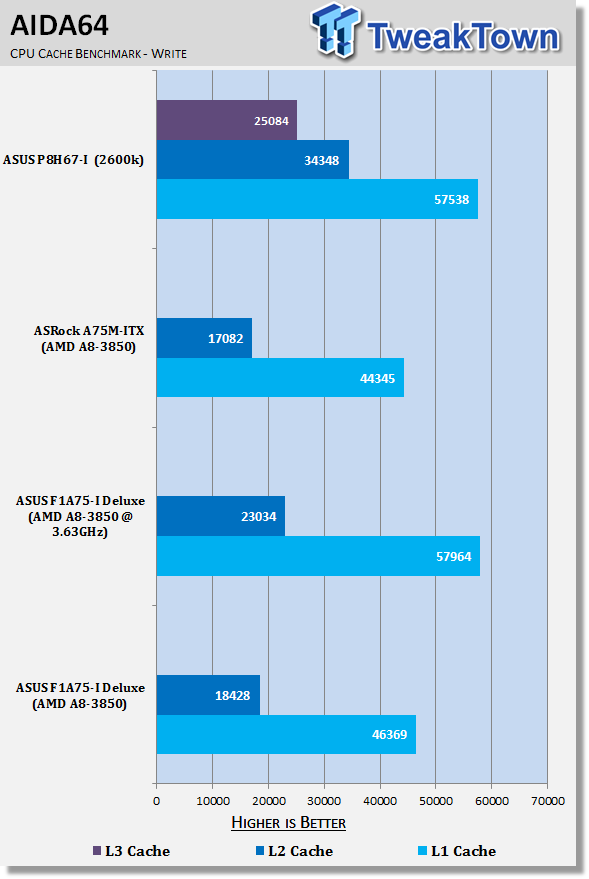
At stock we can see that the performance on our ASUS F1A75-I Deluxe is a bit stronger than our ASRock offering at stock. Of course, the overclock we managed to achieve helps give really strong performance and you can see it doesn't sit far away from our H67 / 2600k setup which of course is extremely limited when it comes to overclocking.
System Benchmarks
PCMark 7
Version and / or Patch Used: 1.04
Developer Homepage: http://www.pcmark.com
Product Homepage: http://www.pcmark.com
PCMark 7 includes a range of tests that give different views of your system's performance. In the Advanced Edition you can choose which tests to run. The common use and hardware component tests are unavailable in the Basic Edition.
Overall system performance is measured by the PCMark test. This is the only test that returns an official PCMark score. The Lightweight test measures the system capabilities of entry-level systems and mobility platforms unable to run the PCMark test, but it does not generate a PCMark score. Common use performance is measured by the scenario tests - Entertainment, Creativity and Production - each of which results in a scenario score. Hardware component performance is measured by the hardware tests - Computation and Storage - each of which results in a hardware score.
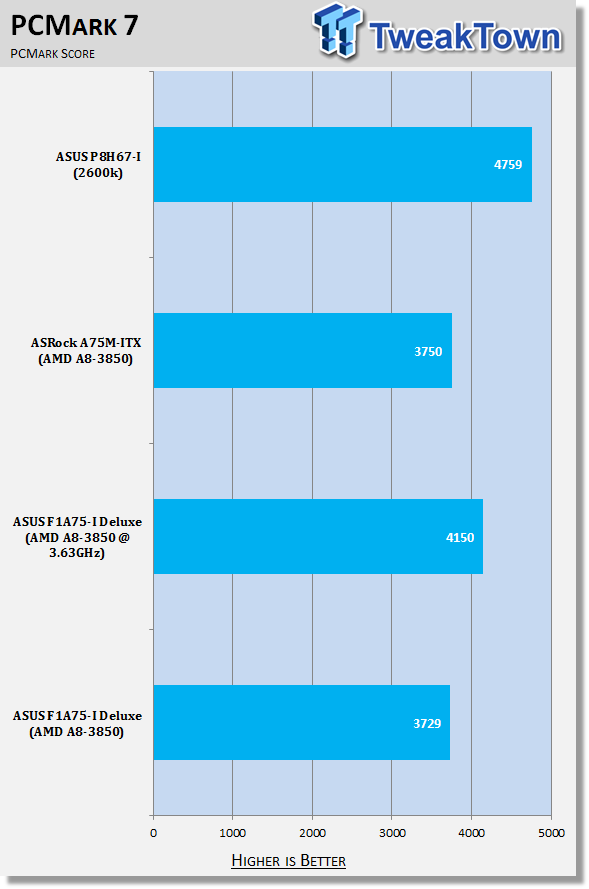
MediaEspresso
Version and / or Patch Used: 6.5
Developer Homepage: http://www.cyberlink.com/
Product Homepage: http://www.cyberlink.com/products/mediaespresso/overview_en_AU.html?fileName=overview&r=1
MediaEspresso is a blazingly fast media universal converter that can transcode your videos, photos and music files and out put them to a huge range of portable devices including mobile phones, portable media players and even game consoles. With technologies like Smart Detect, Direct Sync and CyberLink's TrueTheater™ video enhancements, you can not only forget about complicated format, resolution and output settings, but your converted file will come out the other side looking better than when it went in!
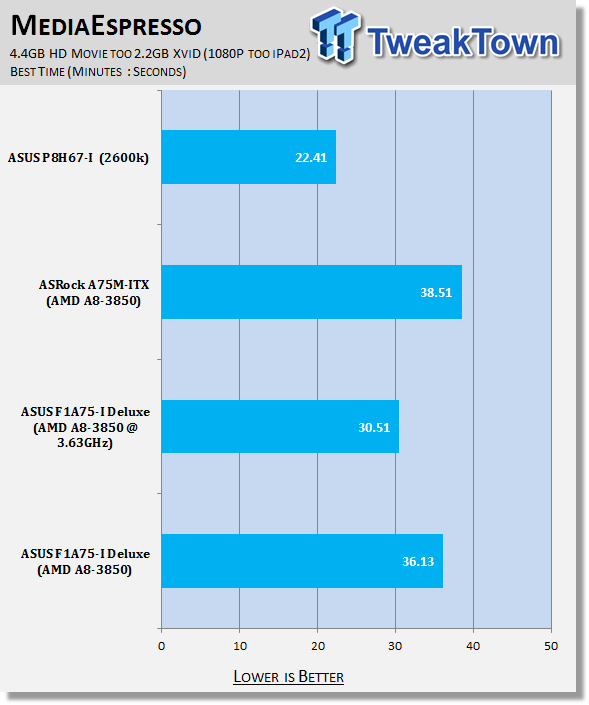
At stock we again see good performance that sits slightly ahead of our other A75 motherboard. Overclocked helps give us a strong performance boost, though, with our MediaEspresso time improving by 20%.
USB 2.0 and 3.0 Benchmarks
AIDA64
Version and / or Patch Used: 1.70.1400
Developer Homepage: http://www.aida64.com
Product Homepage: http://www.AIDA64.com
Replacing Everest in our labs is AIDA64. This new testing suite is from the core development team from Lavalys and continues that tradition. The guys have thrown in better support for multithreaded CPUs as well as full 64 bit support. We use this to test memory and HDDs for now, but may find ourselves opening this up to other areas of the motherboard.
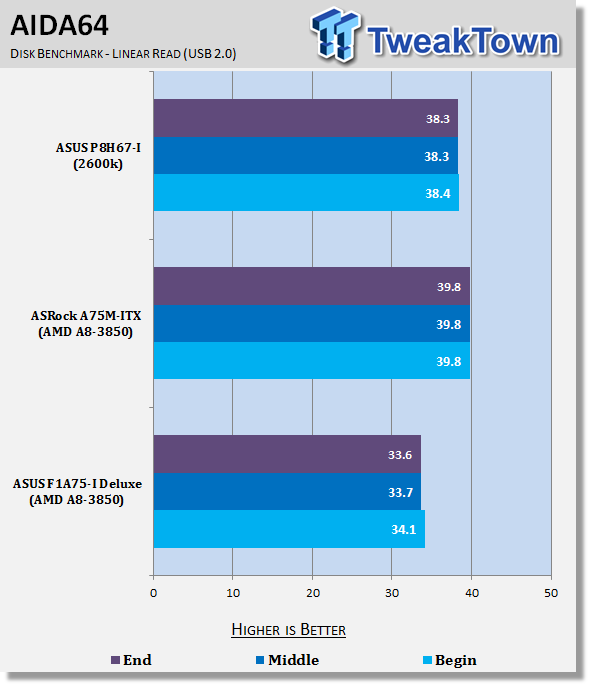
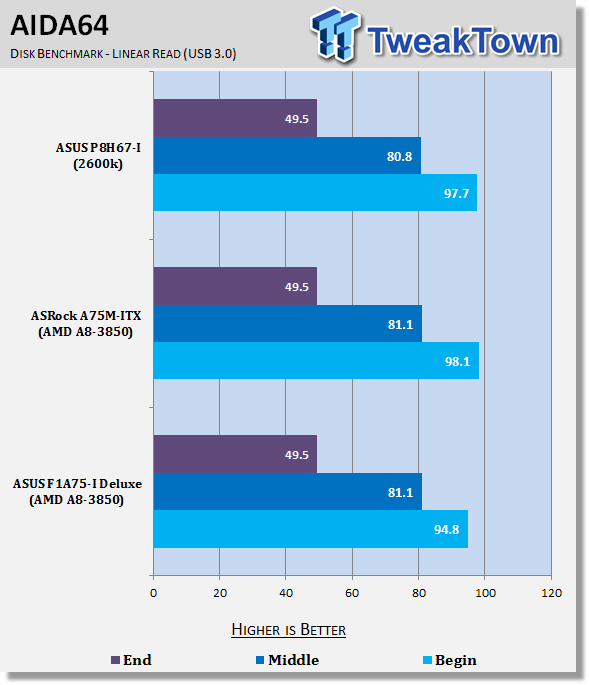
While USB 2.0 performance is a little down, we can see that USB 3.0 performance lines up with our other boards with very little separating them.
SSD Benchmarks
AIDA64
Version and / or Patch Used: 1.70.1400
Developer Homepage: http://www.aida64.com
Product Homepage: http://www.AIDA64.com
Replacing Everest in our labs is AIDA64. This new testing suite is from the core development team from Lavalys and continues that tradition. The guys have thrown in better support for multithreaded CPUs as well as full 64 bit support. We use this to test memory and HDDs for now, but may find ourselves opening this up to other areas of the motherboard.
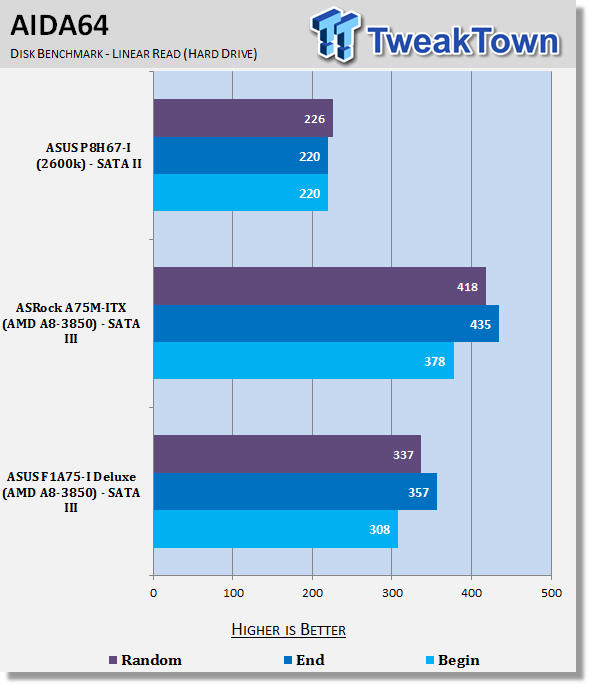
HD Tune Pro
Version and / or Patch Used: 4.61
Developer Homepage: http://www.hdtune.com
Product Homepage: http://www.hdtune.com
HD Tune Pro gives us accurate read, write and access time results and for the last couple of years has been gaining popularity amongst reviewers. It is now considered a must have application for storage device testing.
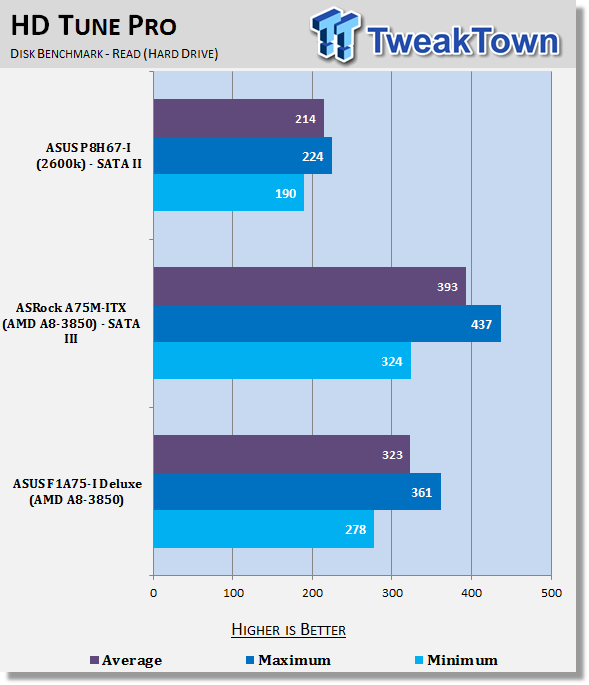
Looking at our SATA III SSD performance, we can see that it comes in a little slower than our other A75 board. It's seen in both our benchmarks, so is of course consistent.
Memory Benchmarks
AIDA64
Version and / or Patch Used: 1.00.1035BETA
Developer Homepage: http://www.aida64.com
Product Homepage: http://www.AIDA64.com
Replacing Everest in our labs is AIDA64. This new testing suite is from the core development team from Lavalys and continues that tradition. The guys have thrown in better support for multithreaded CPUs as well as full 64 bit support. We use this to test memory and HDDs for now, but may find ourselves opening this up to other areas of the motherboard.
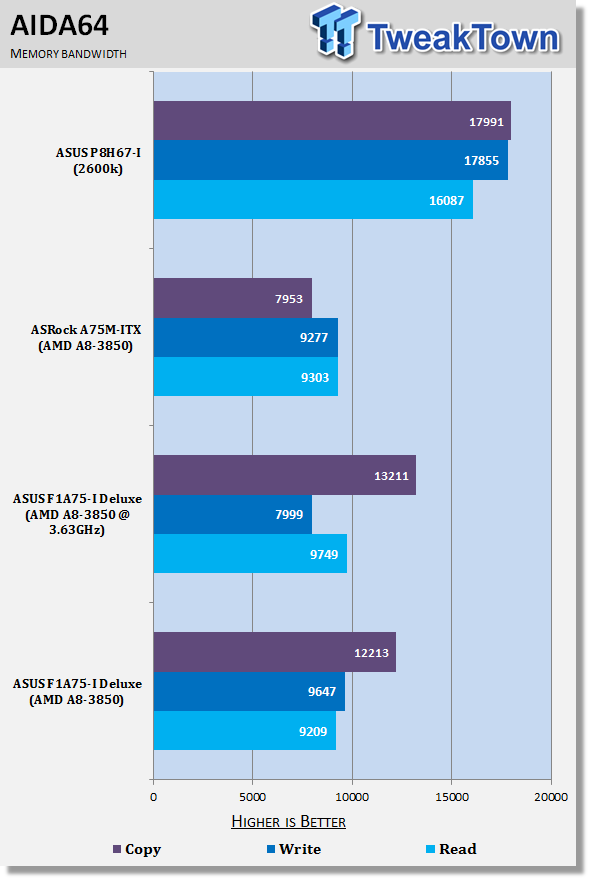
Checking out memory performance, we can see at stock it's a lot stronger than our other A75 offering. Overclocked we see read and copy times improve, but for some reason we see write takes a bit of a dive. Testing multiple times yielded results within a hundred MB/s of each other.
Gaming Benchmarks
3DMark 11
Version and / or Patch Used: 1.0
Developer Homepage: http://www.futuremark.com
Product Homepage: http://www.3dmark.com/3dmark11/
3DMark 11 is the latest version of the world's most popular benchmark. Designed to measure your PC's gaming performance 3DMark 11 makes extensive use of all the new features in DirectX 11 including tessellation, compute shaders and multi-threading. Trusted by gamers worldwide to give accurate and unbiased results, 3DMark 11 is the best way to consistently and reliably test DirectX 11 under game-like loads.
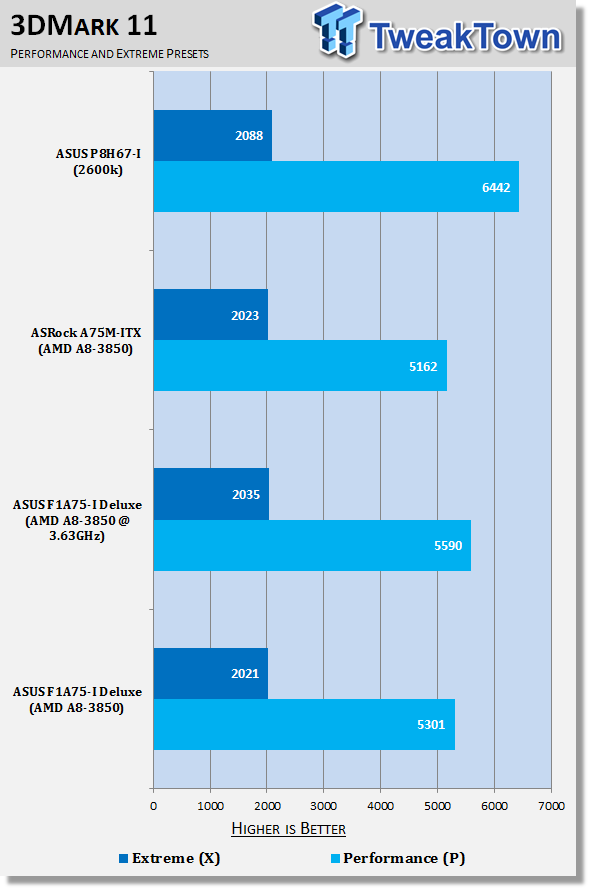
Metro 2033
Version and / or Patch Used: Latest Steam Update
Timedemo or Level Used: Built in Benchmark
Developer Homepage: http://www.4a-games.com//
Product Homepage: http://www.thqnordic.com/
Metro 2033 is an action-oriented video game with a combination of survival horror and first-person shooter elements. The game is based on the novel Metro 2033 by Russian author Dmitry Glukhovsky. It was developed by 4A Games in Ukraine and released in March 2010 for Microsoft Windows and Xbox 360.[3] In March 2006, 4A Games announced a partnership with Glukhovsky to collaborate on the game.[4] The game was announced at the 2009 Games Convention in Leipzig;[5] a first trailer came along with the announcement.[6] A sequel was announced, currently titled Metro: Last Light.
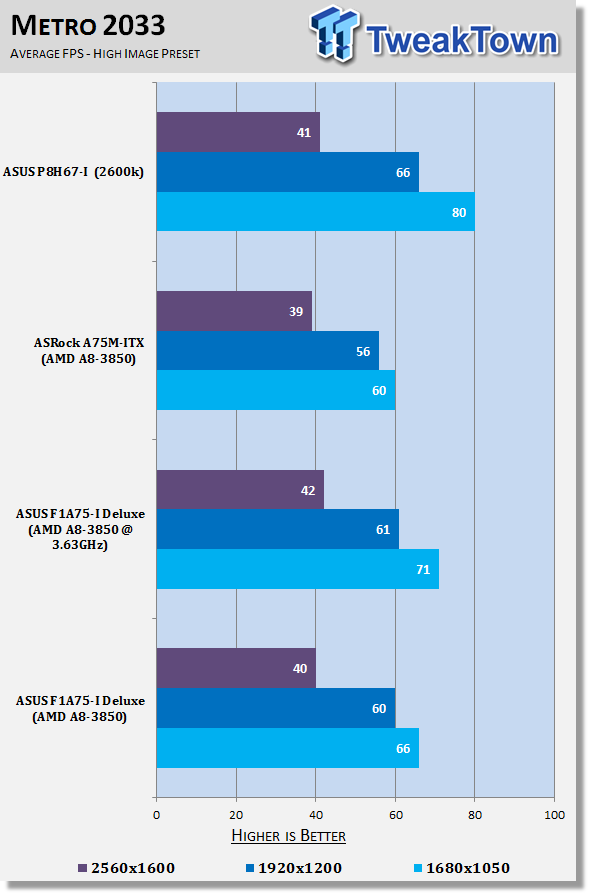
Looking at the gaming performance, we can see on a whole we're slower than the H67 / 2600k offering because that setup gives our GPU more breathing room. Of course, most people are going to find they're not going to use a GTX 580 in this board, so it's not the most important fact.
What is important, though, is the strong performance we're seeing from the ASUS offering compared to our other A75 board here. We can see some strong gains on our ASUS offering that become even stronger thanks to the overclock.
Temperature and Power
Power Draw Tests
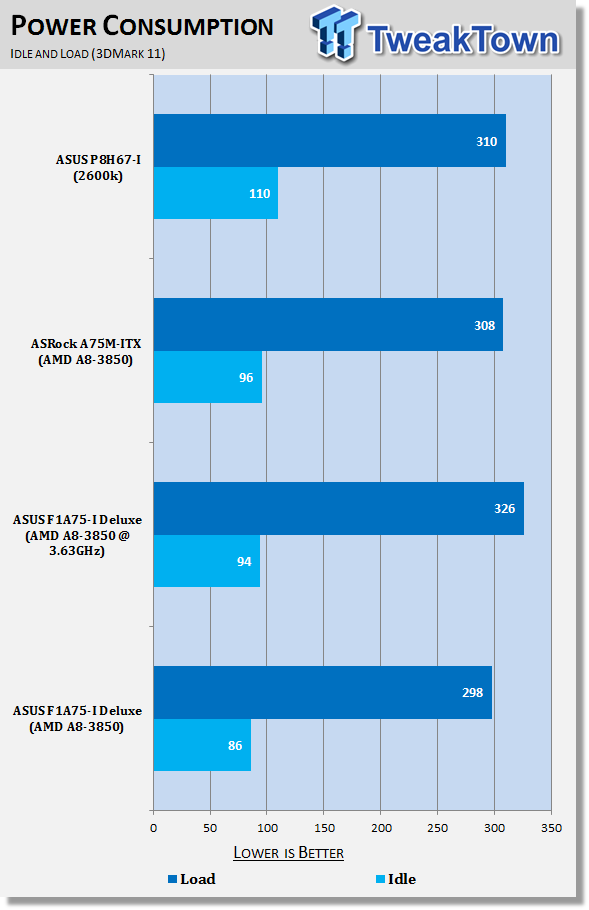
Looking at power draw, we can see our idle looks good and comes in lower than our other setups. What's a surprise is just how little power draw jumps up when overclocked. While it does indeed jump up, it's only by a very small amount.
Core Temperature
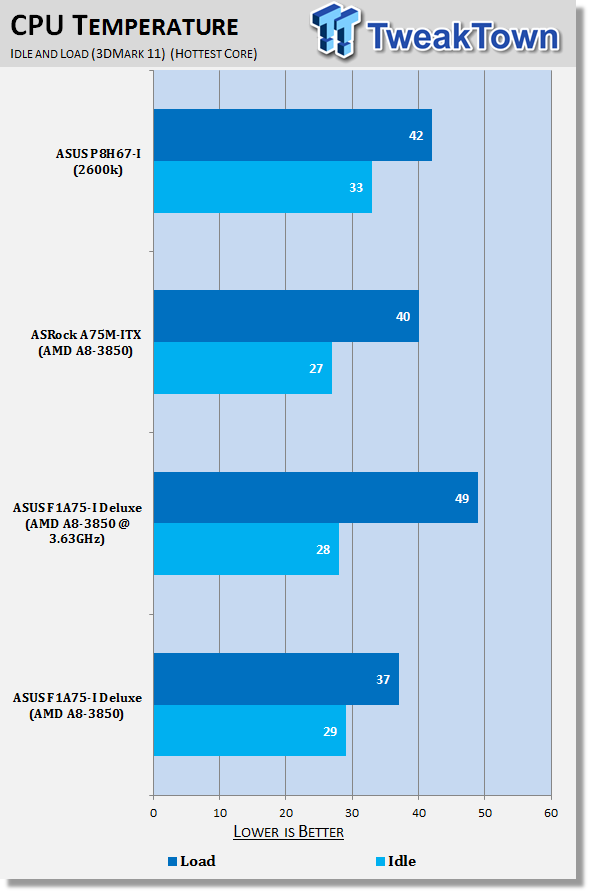
Looking at heat, we can see that the ASUS board is again very strong and I think it's got a lot to do with the fact they've opted for a really strong heatsink around the CPU area. You can see when overclocking, while we do see an increase in heat, it's not that high, which is a surprise considering the overclock we managed to get on the board.
Final Thoughts
I think the first thing that needs to be covered here is the overclock we managed to achieve. As we've already said here today, mITX boards tend not to yield much in terms of overclocking, because the boards just aren't cooled as effectively as larger ones and they only have 4-Pin connectors for CPU instead of the normal 8-Pin we see on most boards.
Moving away from the overclock and onto the board itself, we've got a really good setup on offer. ASUS have managed to pack a lot onto the board and some of the features that really stand out include the integration of a Bluetooth header and the wireless networking which is made quite strong with two antennas included.
Moving onto the bundle, you've got the usual bits and pieces we're used to seeing along with the antennas we've just mentioned. The big stand out in the bundle is the remote, though, which is really strong as it not only offers those typical media buttons, but on the flip side you've got a whole QWERTY keyboard on offer which makes it just so much more helpful.
ASUS has just put together a really strong board and if you looked at the feature list and the bundle, you'd be surprised to find out it's all packed into a mITX offering. Combining the F1A75-I Deluxe with an A8-3850 and a HD 6670 which can be CrossFired against the on board GPU embedded in the APU, you end up with a really beasty system that is extremely small.
Thanks to the fact that you can also CrossFire that HD 6670 with the A8-3850 means that while the i7 / i5 platform may have more CPU headroom, as soon as you start to look at anything VGA dependent the A75 machine is just going to kill it. I think it's in these small mITX boards where we can really see the power of what the onboard GPU is able to do.
The only thing we don't know at the moment is the price of the board, but in typical ASUS fashion it's going to carry a slight premium over other boards. The question we need to answer, though, is the premium worth it? I'd say yes in a heartbeat! We've got a strong feature set, really good bundle and just a board that performs really well.
If you're interested in jumping on the A75 bandwagon, want something that's tiny and can pack quite the punch, the ASUS F1A75-I Deluxe is just an awesome board.

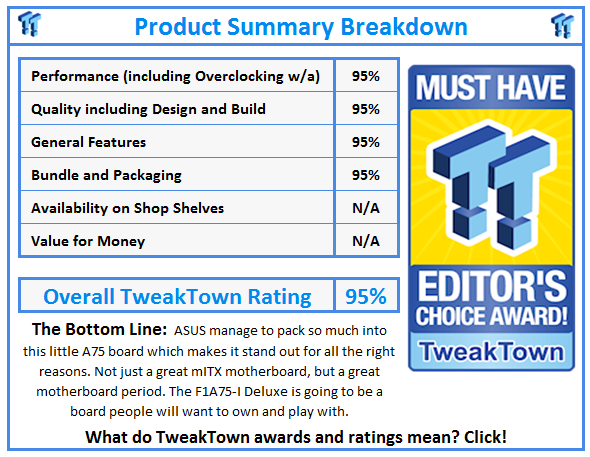
 United
States: Find other tech and computer products like this
over at
United
States: Find other tech and computer products like this
over at  United
Kingdom: Find other tech and computer products like this
over at
United
Kingdom: Find other tech and computer products like this
over at  Australia:
Find other tech and computer products like this over at
Australia:
Find other tech and computer products like this over at  Canada:
Find other tech and computer products like this over at
Canada:
Find other tech and computer products like this over at  Deutschland:
Finde andere Technik- und Computerprodukte wie dieses auf
Deutschland:
Finde andere Technik- und Computerprodukte wie dieses auf